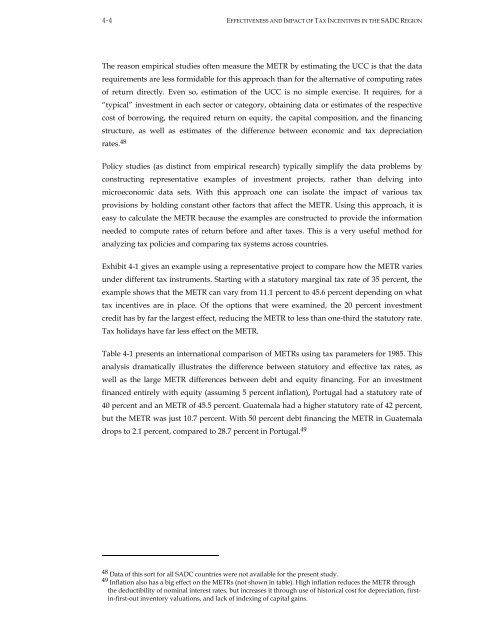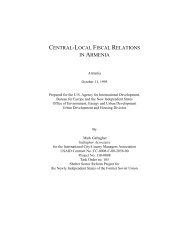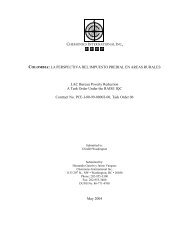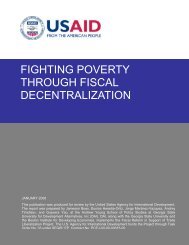Effectiveness and Economic Impact of Tax Incentives in the SADC ...
Effectiveness and Economic Impact of Tax Incentives in the SADC ...
Effectiveness and Economic Impact of Tax Incentives in the SADC ...
You also want an ePaper? Increase the reach of your titles
YUMPU automatically turns print PDFs into web optimized ePapers that Google loves.
4-4 EFFECTIVENESS AND IMPACT OF TAX INCENTIVES IN THE <strong>SADC</strong> REGION<br />
The reason empirical studies <strong>of</strong>ten measure <strong>the</strong> METR by estimat<strong>in</strong>g <strong>the</strong> UCC is that <strong>the</strong> data<br />
requirements are less formidable for this approach than for <strong>the</strong> alternative <strong>of</strong> comput<strong>in</strong>g rates<br />
<strong>of</strong> return directly. Even so, estimation <strong>of</strong> <strong>the</strong> UCC is no simple exercise. It requires, for a<br />
“typical” <strong>in</strong>vestment <strong>in</strong> each sector or category, obta<strong>in</strong><strong>in</strong>g data or estimates <strong>of</strong> <strong>the</strong> respective<br />
cost <strong>of</strong> borrow<strong>in</strong>g, <strong>the</strong> required return on equity, <strong>the</strong> capital composition, <strong>and</strong> <strong>the</strong> f<strong>in</strong>anc<strong>in</strong>g<br />
structure, as well as estimates <strong>of</strong> <strong>the</strong> difference between economic <strong>and</strong> tax depreciation<br />
rates. 48<br />
Policy studies (as dist<strong>in</strong>ct from empirical research) typically simplify <strong>the</strong> data problems by<br />
construct<strong>in</strong>g representative examples <strong>of</strong> <strong>in</strong>vestment projects, ra<strong>the</strong>r than delv<strong>in</strong>g <strong>in</strong>to<br />
microeconomic data sets. With this approach one can isolate <strong>the</strong> impact <strong>of</strong> various tax<br />
provisions by hold<strong>in</strong>g constant o<strong>the</strong>r factors that affect <strong>the</strong> METR. Us<strong>in</strong>g this approach, it is<br />
easy to calculate <strong>the</strong> METR because <strong>the</strong> examples are constructed to provide <strong>the</strong> <strong>in</strong>formation<br />
needed to compute rates <strong>of</strong> return before <strong>and</strong> after taxes. This is a very useful method for<br />
analyz<strong>in</strong>g tax policies <strong>and</strong> compar<strong>in</strong>g tax systems across countries.<br />
Exhibit 4-1 gives an example us<strong>in</strong>g a representative project to compare how <strong>the</strong> METR varies<br />
under different tax <strong>in</strong>struments. Start<strong>in</strong>g with a statutory marg<strong>in</strong>al tax rate <strong>of</strong> 35 percent, <strong>the</strong><br />
example shows that <strong>the</strong> METR can vary from 11.1 percent to 45.6 percent depend<strong>in</strong>g on what<br />
tax <strong>in</strong>centives are <strong>in</strong> place. Of <strong>the</strong> options that were exam<strong>in</strong>ed, <strong>the</strong> 20 percent <strong>in</strong>vestment<br />
credit has by far <strong>the</strong> largest effect, reduc<strong>in</strong>g <strong>the</strong> METR to less than one-third <strong>the</strong> statutory rate.<br />
<strong>Tax</strong> holidays have far less effect on <strong>the</strong> METR.<br />
Table 4-1 presents an <strong>in</strong>ternational comparison <strong>of</strong> METRs us<strong>in</strong>g tax parameters for 1985. This<br />
analysis dramatically illustrates <strong>the</strong> difference between statutory <strong>and</strong> effective tax rates, as<br />
well as <strong>the</strong> large METR differences between debt <strong>and</strong> equity f<strong>in</strong>anc<strong>in</strong>g. For an <strong>in</strong>vestment<br />
f<strong>in</strong>anced entirely with equity (assum<strong>in</strong>g 5 percent <strong>in</strong>flation), Portugal had a statutory rate <strong>of</strong><br />
40 percent <strong>and</strong> an METR <strong>of</strong> 45.5 percent. Guatemala had a higher statutory rate <strong>of</strong> 42 percent,<br />
but <strong>the</strong> METR was just 10.7 percent. With 50 percent debt f<strong>in</strong>anc<strong>in</strong>g <strong>the</strong> METR <strong>in</strong> Guatemala<br />
drops to 2.1 percent, compared to 28.7 percent <strong>in</strong> Portugal. 49<br />
48 Data <strong>of</strong> this sort for all <strong>SADC</strong> countries were not available for <strong>the</strong> present study.<br />
49 Inflation also has a big effect on <strong>the</strong> METRs (not shown <strong>in</strong> table). High <strong>in</strong>flation reduces <strong>the</strong> METR through<br />
<strong>the</strong> deductibility <strong>of</strong> nom<strong>in</strong>al <strong>in</strong>terest rates, but <strong>in</strong>creases it through use <strong>of</strong> historical cost for depreciation, first<strong>in</strong>-first-out<br />
<strong>in</strong>ventory valuations, <strong>and</strong> lack <strong>of</strong> <strong>in</strong>dex<strong>in</strong>g <strong>of</strong> capital ga<strong>in</strong>s.











